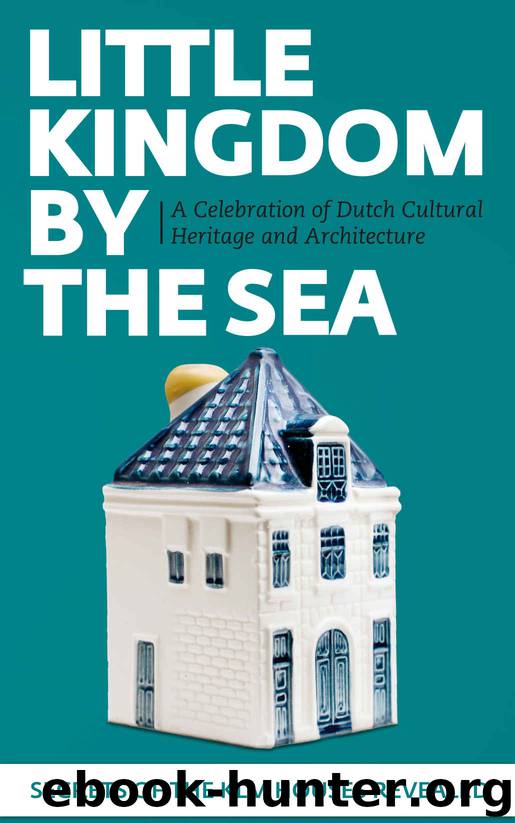Little Kingdom by the Sea: Secrets of the KLM Houses Revealed, a Celebration of Dutch Cultural Heritage and Architecture by Mark Zegeling

Author:Mark Zegeling [Zegeling, Mark]
Language: eng
Format: epub
Publisher: MarkMedia & Art
Published: 2015-04-23T21:00:00+00:00
#48
Jodenbreestraat 4, Amsterdam
The Dramatic Life and Times of Rembrandt — The Greatest Artist of the Golden Age
During the Eighty Years’ War thousands of people from all over Europe fled to the liberal north to escape the Spanish Inquisition and the ruthless Catholic king, Philip II. Many of the refugees came from intellectual circles and the upper classes. When they arrived in Amsterdam, it was not unusual for them to have a house built on one of the city’s new canals. With the influx of all this knowledge and money, the immigrants gave a huge boost to the economy.
In 1606, the year Rembrandt van Rijn was born in Leiden, Hans van der Voort purchased three vacant plots on Jodenbreestraat. The successful tailor fled Antwerp for the free Dutch Republic with his brother Cornelis some years ago and had lived in Amsterdam ever since. The brothers commissioned two houses with stepped gables in the Dutch Renaissance style typical of the day. Hans moved into the building at Jodenbreestraat 4; Cornelis into the house on the corner, where he opened an art gallery. The house at Jodenbreestraat 4 was sold again in 1608 to another refugee from Antwerp, the merchant Pieter Belten.
Jewish Broadway
Less fortunate refugees from eastern and southern Europe, as well as many artists, were attracted to the cheaper east of the city. After many Jewish immigrants from Spain and Portugal settled in the area, the name Sint Antonies Breestraat (Saint Anthony’s Broadway) was changed during the Golden Age to Jodenbreestraat (Jewish Broadway).
Smitten by an orphan girl
When Pieter Belten died in 1626, his two children from his first marriage, Pieter Jr. and Magdalena, inherited the house. Pieter was an adult, but his sister was just sixteen and as a minor, she was appointed a guardian. His name was Anthonie Thijs, a jeweler from Flanders and a widower twice her age. He became completely smitten by the girl and a year after the death of her father, the guardian married his young charge. Anthonie and Magdelena moved into her parental home on Jodenbreestraat 4, together with her brother Pieter and his wife.
An extra storey was built on top of the front part of the house and at the same time, the outdated stepped gable was replaced by a cornice and tympanum, style elements typical of Dutch classicism and much more in keeping with the latest fashion. It was quite possible that the architect responsible for the design of the Royal Palace on Dam Square, Jacob van Campen, was involved in the modernization process, for the facade looks similar to others by his hand. Anthonie and Magdelena moved out after six years of marriage, although Magdalena retained co-ownership of the house.
Nuptial celebrations
Meanwhile, next door at Jodenbreestraat 6, the famous artist Rembrandt van Rijn wedded his landlord’s cousin, Saskia. The marriage ceremony itself, however, was held in the parish church in St Annaparochie, Friesland, where Saskia grew up. Rembrandt was so in love with his wife that he presented her with a drawing showing how beautiful she had looked on her wedding day.
Download
This site does not store any files on its server. We only index and link to content provided by other sites. Please contact the content providers to delete copyright contents if any and email us, we'll remove relevant links or contents immediately.
Crystal Cove by Lisa Kleypas(38472)
Spell It Out by David Crystal(35849)
Underground: A Human History of the Worlds Beneath Our Feet by Will Hunt(11840)
For the Love of Europe by Rick Steves(11533)
Tools of Titans by Timothy Ferriss(7818)
Giovanni's Room by James Baldwin(6814)
The Rosie Project by Graeme Simsion(5843)
A Year in the Merde by Stephen Clarke(5080)
Perfect Rhythm by Jae(5074)
Beach Read by Emily Henry(5002)
Spare by Prince Harry The Duke of Sussex(4791)
The Body: A Guide for Occupants by Bill Bryson(4587)
Endurance: Shackleton's Incredible Voyage by Alfred Lansing(4508)
China Rich Girlfriend by Kwan Kevin(4294)
The Silk Roads by Peter Frankopan(4275)
A Game of Thrones 1 by George R R Martin(3988)
Tokyo Vice: An American Reporter on the Police Beat in Japan by Jake Adelstein(3867)
The Motorcycle Diaries by Ernesto Che Guevara(3788)
Alive: The Story of the Andes Survivors by Piers Paul Read(3733)
